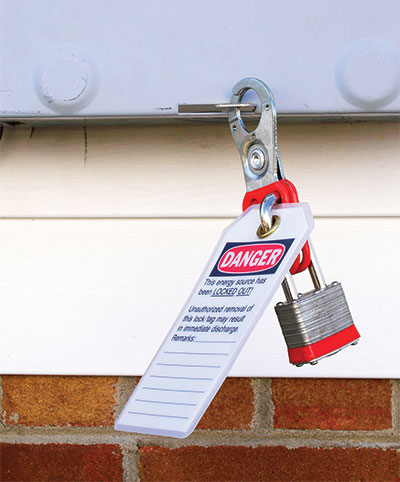
OSHA’s lockout/tagout standard establishes the responsibility of the employer to protect employees from the release of hazardous energy during machine and equipment maintenance.
This article is from the Fall 2015 issue of The Quill. To view the full issue, visit The Quill archive.
John Doe, a mechanic at XYZ Trucking Company, had been repairing the air system on truck #1025 in the company garage. After purging all the air in the system, he began to unbolt the air tank. Doe was interrupted around 11:30 a.m. when he and the rest of the service team left the shop for a mandatory lunch and learn safety meeting. Upon returning to the shop, Doe resumed his repairs on the truck’s air system. He went to remove the air tank drain valve and was knocked unconscious when the valve hit him in the right eye. Ultimately, Doe lost his right eye as a result of the accident.
The above may sound like an isolated incident, or even that Doe did not perform his due diligence to ensure the air system had been purged. What the story did not divulge, however, was the fact that the driver of truck #1025 had come in the shop while everyone was out and assumed his tractor was ready. When he started the truck he noticed the air system was not building air as it should, so he assumed it was not ready and left the shop. Doe, unaware of the events that had taken place in his absence, resumed servicing the tractor.
There are many policies and procedures that could have prevented this accident from occurring, but “The Control of Hazardous Energy,” or lockout/tagout (LOTO), is the most important and most often overlooked procedure by many transportation companies. According to OSHA 29 CFR 1910.147, “energy sources including electrical, mechanical, hydraulic, pneumatic, chemical, thermal or other sources in machines and equipment can be hazardous to workers. During the servicing and maintenance of machines and equipment, the unexpected startup or release of stored energy could cause injury to employees.” OSHA’s LOTO standard (29 CFR 1910.333) establishes the responsibility of the employer to protect employees from the release of hazardous energy during machine and equipment maintenance. The standard also gives employers the flexibility to develop and implement an energy control program that addresses the needs of their specific workplace, and describes the types of machines and equipment that may fall under the LOTO standard.
What must employers do to ensure the protection of employees from the unexpected startup or release of stored energy? Some of the most critical requirements of the standard are as follows:
- Develop, implement and effectively enforce an energy control program.
- Lockout devices must be used for equipment that can be locked out and tagout devices may be used on equipment in lieu of a lockout device only if the tagout program provides employee protection equivalent to that provided through a lockout program.
- All new or overhauled equipment should be capable of accepting a lockout device.
- Develop, document, implement and enforce energy control procedures on all equipment capable of releasing stored energy (tractors, forklifts, air compressors, etc.).
- Use only those LOTO devices approved for the particular equipment or machinery being serviced.
- Use only durable, standardized and substantial devices.
- Ensure the devices identify the individuals performing the application.
- Establish a policy that only permits the employee applying a LOTO device to remove it.
- Inspect energy control procedures at minimum annually, or when a new piece of equipment is introduced within the company/shop.
- Provide effective training for all authorized and affected employees.
Remember, employee safety is your company’s number one priority! For more information on lockout/tagout, please refer to www.osha.gov.